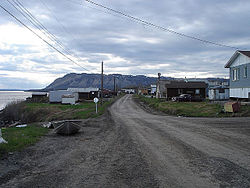Tulita
Tulít’a | |
|---|---|
 | |
| Coordinates: 64°54′02″N 125°34′35″W / 64.90056°N 125.57639°W[1] | |
| Country | Canada |
| Territory | Northwest Territories |
| Region | Sahtu |
| Settlement area | Sahtu |
| Constituency | Sahtu |
| Hamlet | 1 April 1984 |
| Government | |
| • Mayor | Rocky Norwegian Sr. |
| • Senior Administrative Officer | Bradley Menacho |
| • MLA | Daniel McNeely |
| Area (2021)[2] | |
| • Land | 52.28 km2 (20.19 sq mi) |
| Elevation | 101 m (331 ft) |
| Population (2021)[2] | |
| • Total | 396 |
| • Density | 7.6/km2 (20/sq mi) |
| Time zone | UTC−07:00 (MST) |
| • Summer (DST) | UTC−06:00 (MDT) |
| Canadian Postal code | X0E 0K0 |
| Area code | 867 |
| Telephone exchange | 588 |
| - Living cost | 177.5A |
| - Food price index | 165.8B |
| Sources: Department of Municipal and Community Affairs,[3] Prince of Wales Northern Heritage Centre,[4] Tulita profile at the Legislative Assembly[5] Canada Flight Supplement[6] ^A 2013 figure based on Edmonton = 100[7] ^B 2015 figure based on Yellowknife = 100[7] | |
Tulita,[pronunciation?] which in Slavey means "where the rivers or waters meet", is a hamlet in the Sahtu Region of the Northwest Territories, Canada. It was formerly known as Fort Norman, until 1 January 1996. It is located at the junction of the Great Bear River and the Mackenzie River; the Bear originates at Great Bear Lake adjacent to Deline.
Tulita is in an area that is forested and well south of the tree line. Permafrost underlays the area, more or less continuous in distribution. Tulita is surrounded by mountains, the latter renowned for Dall sheep, and faces the Mackenzie Mountains to the west, which has mountain goats.
- ^ "Tulita". Geographical Names Data Base. Natural Resources Canada.
- ^ a b Cite error: The named reference
2021censuswas invoked but never defined (see the help page). - ^ "NWT Communities - Tulita". Government of the Northwest Territories: Department of Municipal and Community Affairs. Retrieved 20 January 2014.
- ^ "Northwest Territories Official Community Names and Pronunciation Guide". Prince of Wales Northern Heritage Centre. Yellowknife: Education, Culture and Employment, Government of the Northwest Territories. Archived from the original on 13 January 2016. Retrieved 13 January 2016.
- ^ Cite error: The named reference
ledgewas invoked but never defined (see the help page). - ^ Canada Flight Supplement. Effective 0901Z 16 July 2020 to 0901Z 10 September 2020.
- ^ a b Tulita - Statistical Profile at the GNWT

